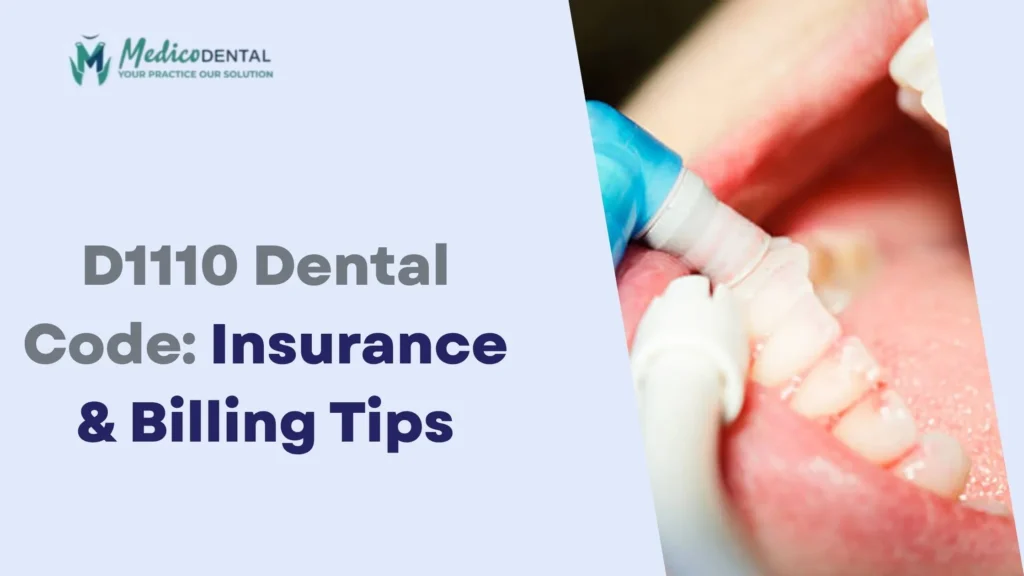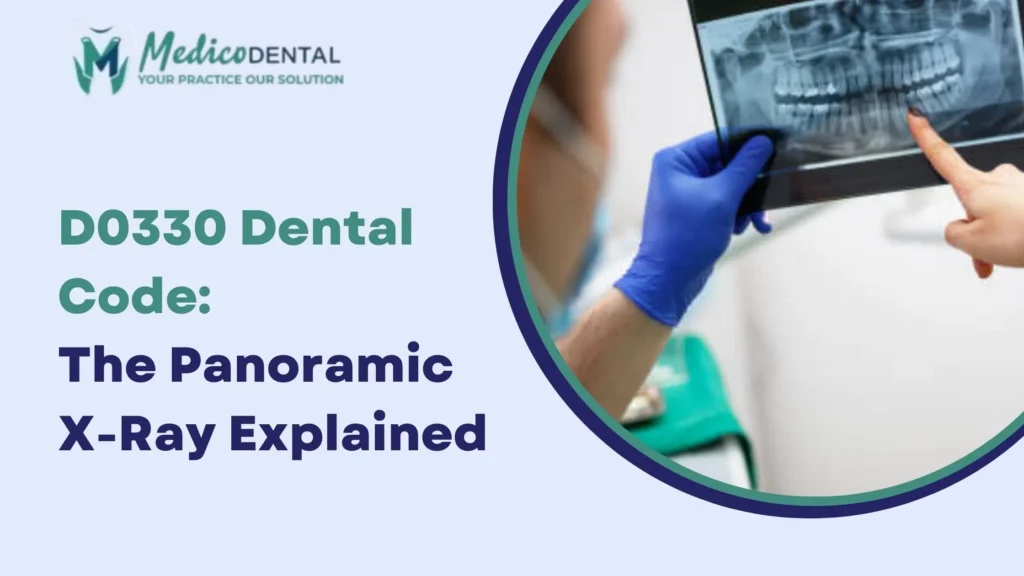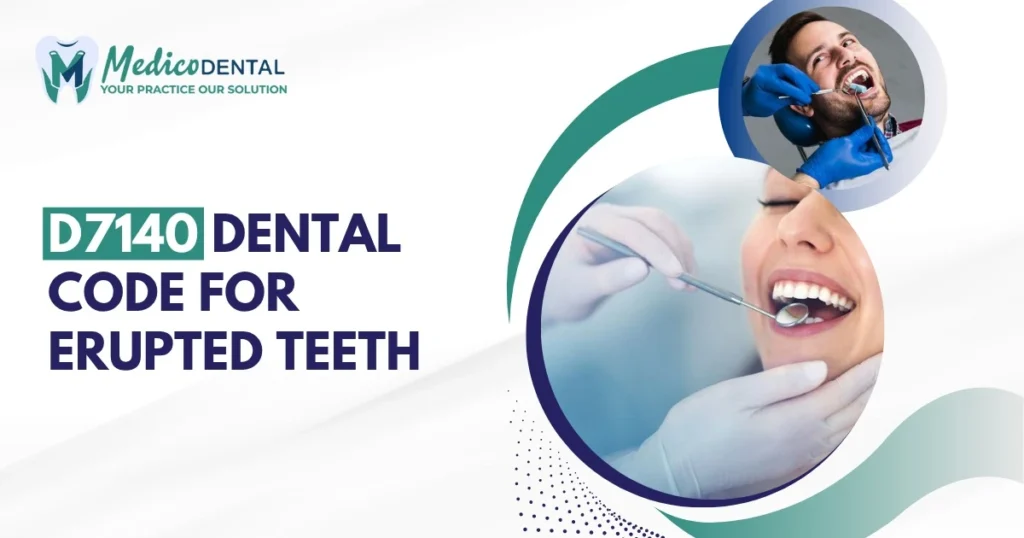D1110 Dental Code for Prophylaxis, Adult is one of the most common ways to keep adult smiles healthy and bright. Prophylactic dental cleanings are very important for keeping adult patients’ mouths healthy. This process gets rid of plaque, tartar, and stains on teeth to help stop gum disease, cavities, and other oral health problems from happening in the first place. This way, dental professionals can save patients money by using less invasive, more expensive treatments later on. This article covers everything you need to know about the D1110 dental code, including what it is, who can use it, and how to bill for it.
What is D1110 dental code?
D1110 dental code or “Prophylaxis, Adult,” is a dental procedure code used to describe a routine teeth cleaning performed on adult patients. This procedure is primarily aimed at preventing oral health issues like gum disease and cavities by removing plaque, tartar (calculus), and stains from the teeth. It’s an essential part of maintaining good oral hygiene and is commonly performed every six months as a preventive measure.
Purpose and Importance of D1110 dental code in Preventive Dentistry
D1110 dental code is crucial in preventive dentistry because it addresses the earliest stages of oral health problems before they develop into more severe conditions like gum disease or cavities. Regular cleanings help reduce the risk of plaque buildup, which, if left untreated, can lead to inflammation of the gums (gingivitis) or more serious periodontal disease. Preventive care also helps identify any early signs of dental issues that may require further attention.
By using D1110 for routine cleanings, dental professionals can keep patients’ mouths healthy, reduce their risk of needing more intensive treatments, and save them money in the long run by avoiding complex procedures.
What Does D1110 Dental Code Involve?
D1110 dental code is more than just a simple teeth cleaning. It involves a series of steps designed to thoroughly clean the teeth and gums, promoting overall oral health.
Step-by-Step Procedure
Removal of Plaque and Calculus
The first part of the procedure involves removing plaque and tartar (calculus) from the surfaces of the teeth. Plaque is a soft, sticky film that builds up on teeth, and if not removed, it hardens into tartar, which can only be cleaned by a professional. The dental hygienist uses specialized tools, such as scalers, to carefully remove these deposits from the teeth, especially around the gumline where plaque is most likely to accumulate.
Polishing of Teeth
After removing plaque and tartar, the next step is to polish the teeth. Polishing smooths the enamel and removes any remaining stains caused by food, drink, or smoking. This not only improves the appearance of your smile but also makes it more difficult for plaque to adhere to the tooth surfaces in the future.
Oral Hygiene Instructions
To help patients maintain their oral health at home, the dental professional will provide personalized oral hygiene instructions. This includes guidance on proper brushing, flossing, and other daily oral care habits. Effective home care is essential to prevent plaque buildup and to maintain the results of the cleaning.
Fluoride Treatment and Varnish
In some cases, the dental hygienist may apply fluoride treatment or varnish after the cleaning. Fluoride helps to strengthen tooth enamel, making it more resistant to decay. Fluoride treatments are especially beneficial for patients who are prone to cavities or who have recently undergone a cleaning that removed a lot of plaque and tartar.
Eligibility for D1110
D1110 is typically reserved for patients who are healthy and do not have significant gum disease. However, there are certain eligibility requirements for this procedure.
Who is Eligible for D1110?
D1110 is intended for adult patients who are generally in good oral health and have not undergone periodontal therapy (like scaling or root planing). If you have healthy gums or mild gingivitis, this is the procedure that your dentist will likely recommend for routine maintenance.
Age Requirements
The D1110 dental code is used for adult patients, generally those aged 14 years or older. The treatment is not appropriate for younger children, as their dental needs often require a different code (D1120 for child prophylaxis).
Healthy Gums vs. Gingivitis
While D1110 dental code is designed for patients with healthy gums, it can also be used for those with mild gingivitis (early-stage gum disease). If you have bleeding gums or signs of gum irritation but no severe periodontal issues, your dentist may still use this code to clean your teeth and help reverse gingivitis before it progresses.
Conditions Excluded from D1110
D1110 dental code is not appropriate for individuals who have moderate to severe periodontitis (advanced gum disease). If you are experiencing significant gum loss, deep pockets, or chronic inflammation, your dentist may recommend a different procedure, such as D4910 (periodontal maintenance therapy). D4910 is intended for patients with more severe gum disease who require ongoing treatment to manage the condition.
D1110 vs. Other Dental Codes
While D1110 is a commonly used code for routine cleanings, it’s essential to understand the differences between it and other dental procedure codes, particularly those that relate to periodontal care.
D1110 vs. D4910: Prophylaxis vs. Periodontal Maintenance
D1110 (Prophylaxis, Adult): This code is for patients with healthy gums or mild gingivitis, and it focuses on routine cleaning to prevent gum disease. It’s generally recommended for patients who are not experiencing significant gum issues.
D4910 (Periodontal Maintenance): This code is for patients who have advanced gum disease or have undergone previous periodontal therapy, such as scaling or root planing. D4910 is used for ongoing maintenance to prevent the recurrence of periodontal disease. Patients with moderate to severe periodontitis need more frequent cleaning and specialized care, which is why D4910 is necessary.
D1110 vs. D1120: Child Prophylaxis vs. Adult Prophylaxis
D1110 (Adult Prophylaxis): As mentioned, this is used for adult patients, typically over the age of 14, to perform a regular cleaning and prevent dental issues. It is tailored for more mature patients with adult dentition.
D1120 (Child Prophylaxis): This code is used for children under 14 to remove plaque and tartar from their teeth. While it involves similar procedures to D1110, it is typically adjusted to accommodate the smaller teeth and developing dental structure of younger patients.
Insurance Coverage for D1110
Understanding insurance coverage for dental procedures like D1110 can be a bit tricky, as policies vary between providers. However, it’s important for both dental professionals and patients to know what to expect regarding coverage and frequency.
What Insurance Plans Cover D1110?
Most dental insurance plans cover D1110 because it is considered a preventive procedure. Preventive care, including regular teeth cleanings, is typically a core part of dental plans, aimed at maintaining oral health and preventing more costly treatments down the line. However, the extent of coverage depends on the specific policy and provider.
Traditional Dental Insurance: Most standard dental insurance policies cover D1110, typically with one cleaning allowed per 6 months. This is standard in many plans.
PPO and HMO Plans: Both types of plans usually cover D1110, but PPO plans may offer more flexibility with provider choice. HMO plans might have stricter networks and limited coverage options.
Medicaid and State Programs: Coverage for D1110 varies by state. Some states provide full coverage for routine cleanings under Medicaid, while others may limit the frequency of coverage or restrict the procedure to certain age groups.
Frequency and Limitations
Frequency: Most dental insurance plans allow for two cleanings per year (every 6 months). If you are due for a second cleaning within the same year, you will likely need to meet specific criteria, such as having a higher risk for gum disease or a history of periodontal issues. In some cases, additional diagnostic procedures, such as a D0330 Dental Code (panoramic radiographic image), may also be required to assess your overall oral health before approving further treatments.
Limitations: Even if your plan covers D1110, some insurers impose limits on how often you can receive the procedure. Additionally, coverage can be denied if the procedure is deemed unnecessary, or if the patient has an ongoing oral health issue that requires more specialized treatment (e.g., periodontal maintenance with D4910).
Common Coverage Denials and How to Avoid Them
Denied Due to Frequency: If your insurance only allows one cleaning per year, and you request a second one, coverage might be denied. To avoid this, always check your plan’s terms to understand the number of cleanings allowed and any special requirements for additional coverage.
Incorrect Coding: A frequent cause of claim denials is incorrect coding. For example, if a patient has severe gum disease and a D1110 is billed instead of a D4910, it could result in a denial. Ensure that the correct procedure code is used for the patient’s specific oral health condition.
Failure to Document Medical Necessity: If a patient has more severe gum inflammation or a history of periodontal disease, but the procedure code used is D1110 instead of a more appropriate code (like D4346), insurance may not cover the procedure. Proper documentation of the patient’s oral health status is essential to ensure coverage.
When to Use D1110
Understanding when to use D1110 is critical for ensuring proper treatment and avoiding errors in coding and billing.
Appropriate Patients for D1110
D1110 is appropriate for patients who are in good oral health and have healthy gums or mild gingivitis. This code is designed for patients who do not have advanced gum disease or significant periodontal issues.
Healthy Adults: D1110 is primarily used for healthy adults who need a routine cleaning to maintain oral health.
Mild Gingivitis: If a patient has early-stage gum disease (mild gingivitis), D1110 is still an appropriate choice, as it addresses plaque buildup and helps prevent progression to more severe forms of gum disease.
No Periodontal History: D1110 should not be used if the patient has a history of periodontal disease that has required intensive treatments like scaling and root planing. Instead, codes like D4910 (periodontal maintenance) would be more appropriate for these patients.
Situations That Require Different Codes (e.g., Periodontitis)
Moderate to Severe Gum Disease: If a patient exhibits moderate or severe periodontitis, they will require a more intensive procedure, such as D4346 (scaling in the presence of inflammation) or D4910 (periodontal maintenance therapy). These procedures are tailored to patients who need more frequent care or more intensive cleanings due to deeper pockets, gum loss, or ongoing periodontal therapy.
Periodontal Maintenance: After initial periodontal therapy (like scaling and root planing), patients are often placed on D4910 for maintenance care. This is a different type of cleaning aimed at patients with a history of periodontal disease.
Child Patients: D1110 is for adults, while children typically receive D1120 (child prophylaxis). Children’s teeth and gums are different, and they often require a different approach due to their developing dental structures.
Tips for Proper Billing and Documentation
Proper dental billing and documentation are essential for successful claims processing and to avoid issues with insurance coverage.
How to Ensure Proper Coding for D1110
Verify the Patient’s Oral Health Status: Before selecting D1110, ensure the patient has healthy gums or only mild gingivitis. If there are any signs of more advanced gum disease or periodontal conditions, consider using a more appropriate code like D4910.
Use the Correct Code: Always ensure the correct procedure code is used for the services provided. If the patient has any complications or special conditions (such as pregnancy, medical issues affecting oral health, etc.), these should be documented appropriately.
Pre-Authorization: Some insurance plans may require pre-authorization for dental cleanings, especially if a patient has not had a cleaning in over a year. It’s important to check with the insurance provider to ensure the cleaning will be covered.
Documentation Best Practices
Complete Patient Records: Record detailed notes about the patient’s oral health status, including gum health, presence of plaque or calculus, and any signs of gingivitis or other conditions. This will help justify the use of D1110 and ensure there are no issues with the insurance claim.
Include Treatment Notes: Be sure to document the procedures performed, including scaling, polishing, and any additional treatments like fluoride application. Clear documentation supports the billing process and helps resolve any potential disputes or denials.
Track Patient History: For patients with a history of periodontal disease, it is vital to keep a record of their treatment history and ongoing care plan. This will help avoid confusion when determining the appropriate code for future visits.
Avoiding Common Coding Mistakes
Incorrect Frequency of D1110: Don’t bill for D1110 more than the allowed frequency (typically once every 6 months unless there are medical exceptions). If more frequent cleanings are necessary, discuss this with the patient’s insurer for approval.
Using D1110 for Periodontal Patients: Always ensure that D1110 is used only for appropriate patients. If the patient requires periodontal maintenance, use D4910 or other suitable codes.
Failure to Match Procedure with Condition: If a patient’s gums show signs of inflammation or periodontitis, avoid using D1110. Instead, select a code that reflects the severity of the condition, like D4346 or D4910.
Summary
D1110 plays a vital role in preventive dental care, ensuring that patients maintain healthy teeth and gums. Regular cleanings help reduce the risk of cavities, gum disease, and other dental issues, improving overall oral health. By utilizing D1110 appropriately, dental professionals can help their patients stay on track with their oral hygiene and avoid more severe, costly treatments in the future.
D1110 is a crucial procedure for adult patients with healthy gums or mild gingivitis, serving as an essential preventive measure to maintain optimal oral health. Dental professionals must ensure proper insurance coding and documentation to guarantee smooth claims processing and avoid potential denials. It’s important to be aware of insurance limitations, including the frequency of coverage, and to always verify a patient’s eligibility before proceeding with treatment. Additionally, correctly identifying when to use D1110, as opposed to other codes like D4910 for periodontal maintenance, is vital for both patient care and compliance with insurance requirements. By following these practices, dental professionals can provide the best care while ensuring they meet both patient needs and insurance expectations.
FAQs
What is D1110 and who is eligible for it?
Ans. D1110 is a dental procedure code for Adult Prophylaxis, which refers to routine dental cleanings for adults. This procedure is recommended for patients aged 14 and older who have healthy gums or mild gingivitis. It helps prevent gum disease, cavities, and other oral health issues by removing plaque, tartar, and stains.
How often can I get a D1110 cleaning?
Ans. Most dental insurance plans cover two cleanings per year (every 6 months) for routine preventive care. However, some plans may allow for more frequent cleanings depending on the patient’s oral health history or specific needs. Always verify your plan’s coverage limitations with your insurance provider.
What is the difference between D1110 and D4910?
Ans. D1110 is for routine preventive cleanings for patients with healthy gums or mild gingivitis. D4910, on the other hand, is used for periodontal maintenance for patients who have advanced gum disease or have undergone periodontal therapy. D4910 involves more intensive care and is used to maintain the patient’s oral health after a periodontal treatment.
Is D1110 covered by insurance?
Ans. Yes, most dental insurance plans cover D1110 as part of preventive care. However, coverage and frequency may vary depending on the specific plan. It is important to check your insurance policy for frequency limitations and any possible exclusions.
Can D1110 be used for children?
Ans. D1110 is specifically for adult patients aged 14 and older. For children, a different code, D1120, is used for routine cleanings, which are adjusted to fit the needs of younger patients and their developing dental structures.



